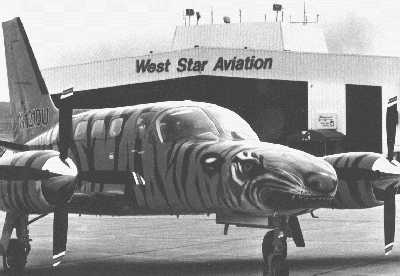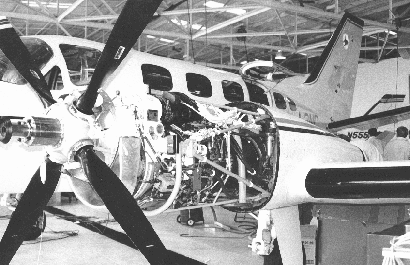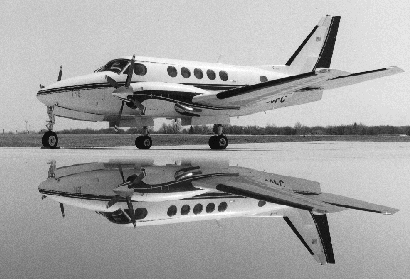
Paul Seidenman/SAN FRANCISCO
Through a series of agreements with authorised service centres, AlliedSignal Engines has been expanding its TPE331-10 turboprop upgrade programme to encompass more general aviation (GA) aircraft. These centres, in conjunction with the Phoenix, Arizona-based manufacturer, have developed supplemental type certificates (STCs) for specific aircraft. These involve modification of installed TPE331-3, -5, -6 and -8 engines to the -10 configuration.
The inclusion of GA aircraft is the latest evolution of a programme begun in 1982 with the Fairchild Metro and Merlin families of turboprop regional airliners.
All of the GA aircraft involved are out-of-production twin turboprops. Originally powered by the Garrett (now AlliedSignal) TPE331 family, they were built in large numbers between the mid-1960s and mid-1980s. Included are the Beech King Air B100, Cessna Conquest II, Rockwell Commander 690A, B, C and D, and the Mitsubishi Mu-2 models J, K, L, M, N and P.
According to Steve Carmickle, AlliedSignal Engines' manager of TPE331 aftermarket programmes, the engine upgrade falls within the certification envelope of each aircraft for which the STCs have been developed. The cost of the upgrade differs by aircraft model, however.
MORE RELIABLE ENGINE
"The upgrade to the TPE331-10 offers the operators of these aircraft reduced ownership costs and a more reliable engine with better performance," says Carmickle. "While performance benefits vary among the aircraft, the programme does result in increased climb and cruise performance and increased temperature margin for hot day operations. In addition, the upgrade to the -10 engines increases the resale value of the aircraft."
In all cases, Carmickle points out, the TPE331 engines are sent to AlliedSignal's overhaul facility in Phoenix for modification to the -10 model. The modifications centre on replacing the existing turbine section with the -10 unit, which includes improved materials in the first and second stage turbines, upgraded turbine coatings and cooled first stage turbine blades and stators. The upgrade to the -10 engine results in a powerplant with a 745kW (1,000shp) thermodynamic rating, up from the 620kW rating of the older variants.
The authorised service centres are responsible for pulling the engine off the aircraft and for re-installing the converted powerplant, along with any airframe modifications required under the STCs. Under the programme, operators can select from two conversion options. One, known as overhaul and convert, is recommended if the engine is close to its 5,400h overhaul interval. The other, the continued time upgrade, can be done at any time between overhauls, although most who choose this route usually elect to do so at 3,600h - the time of the second hot section inspection between overhauls.
With the overhaul and convert option, the hot section components are replaced, upgrading the powerplant to the -10 configuration. At the same time, the entire engine is overhauled to factory specifications. This includes all accessories, such as the fuel control unit, propeller pitch control, propeller governor and fuel pump, as well as valves and other components.
For operators selecting the continued time option, the hot section is also replaced - upgrading the engine to the -10 configuration. At the same time, compressor section refurbishment and gearbox inspections are performed. AlliedSignal checks all accessories for functionality and upgrades them where necessary. The manufacturer also reserves the right to install new, overhauled or serviceable components.
Both approaches include replacement of the high-maintenance interstage turbine temperature (ITT) indicator with a more reliable exhaust gas temperature (EGT) indicator.
AlliedSignal has tailored a factory warranty to each upgrade option. Under both, the turbine section carries a 24-month factory warranty. For either type of upgrade, a choice of two maintenance options is available.
"Operators can stay with the original maintenance schedule for the TPE331-3, -5, -6 and -8 engines," Carmickle says. "This allows a TBO [time between overhauls] of 5,400 flight hours, with an initial hot section inspection at 1,800h and a second hot section plus gearbox inspection at 3,600h." He notes that the more popular choice is the less costly second maintenance option, which offers a TBO of 5,000h. This requires only one hot section inspection at 2,500h, with a gearbox inspection at 5,000h.
Those upgrading to the TPE331-10 can continue to participate - or become enrolled in - AlliedSignal's Maintenance Service Plan (MSP), but at substantial cost savings, says Carmickle. "The 1998 North American MSP rates for the -10 conversion are $38.99 per flight hour, which is about 40-60% less than the MSP on the TPE331-3, -5,-6 and -8," he adds.
The Mitsubishi Mu-2N and P models are the latest to be approved under the programme. The STC, developed by Tulsa, Oklahoma-based Intercontinental Jet, received US Federal Aviation Administration certification in April.
Kenny Morgan, Intercontinental Jet's manager of customer service, reports that under the STC the two Mu-2 models, powered by TPE331-5-252Ms, will be re-engined with the -10T-511M. The modification facility is also pursuing another STC to cover the Mu-2J, K, L and M models. Certification is expected by the fourth quarter of this year.
"This STC will use the AlliedSignal TPE331-10AV as an upgrade from the TPE331-6-251 and -252M engines," Morgan says. With approval of the second STC, AlliedSignal estimates, as many as 260 Mu-2s will be candidate aircraft for the upgrade.
As Morgan explains, the two separate STCs address differences in propeller speeds between the two engines. The -10T-511M model provides a propeller speed of 1,591RPM at 100% engine RPM. The -10AV delivers a propeller speed of 2,000RPM.
Few airframe modifications are needed under the STC. What is required is a new exhaust pipe installation and some rewiring to accommodate the EGT indicator. Also required are airframe bleed air modifications in the engine compartment.
Intercontinental Jet, says Morgan, expects to complete its first Mu-2N conversion by mid-June. "We expect that performance will be equal to or better than that of the Mu-2 Marquise," he says. "The FAA's certification pilot reported that on our first P-model conversion, the rate of climb at 5,000ft [1,500m] was 3,700ft/min [19m/s] at a best climb speed of 140kt [260km/h]. The pilot also reported that the aircraft equalled or exceeded the cruise speeds, as published in the pilot operating manual, for the Mu-2P model."
For operators who elect to upgrade to the TPE331-10T-511M under the continued time option, the total cost of the programme - including removal and re-installation - is $273,000 for both engines. The overhaul and convert option is priced at $403,000. The same prices, Morgan expects, should apply to the -10AV engine upgrade.
One of the first STCs developed for a GA aircraft under the TPE331-10 conversion programme was for the Cessna Conquest II. That STC, developed by West Star Aviation of Grand Junction, Colorado, was issued by the FAA in February 1992. Russ Williams, the company's vice-president of business development, notes that, of the 362 Conquest IIs produced between 1978 and the end of production in 1986, about 330 are still in service. Popular as an executive transport and an owner-flown aircraft, the Conquest II was certified for single pilot operation, and carries up to 10 passengers.
"We have converted 155, or 47%, of the existing fleet, from the original TPE331-8 powerplant to the -10N series," Williams says. "We are continuing to average about two aircraft a month."
He stresses that the project is a joint effort between West Star and AlliedSignal. "We are a major service centre for the TPE331. Because of this, we felt that the modification would be far more marketable by working with the factory on the upgrade programme. In fact, we are the only factory-authorised facility to perform this upgrade on the Conquest II."
As Williams explains, costs vary in accordance with the work. For instance, Conquest II operators which simply want to overhaul (and not upgrade) their TPE331-8s can expect to spend about $290,000 for both engines. Those which choose the continued time upgrade to the -10N model will spend slightly more - $302,000 for both engines. The most expensive option, which involves the full overhaul and conversion, costs $454,000.

TIME CONVERSION PRICE BENEFIT
Not surprisingly, the majority of West Star's customers selecting the upgrade - 115 of the 155 - have picked continued time conversion. Only 40 have chosen to overhaul and convert. As Williams explains, along with the price advantage, the operator has the benefit of the 5,000h TBO on the upgraded engine.
"If an owner decides to do the upgrade at 2,000h, for instance, he can go all the way to 5,000h before looking at a major overhaul," he says. "When we consider that the average Conquest II is used about 300 flight hours a year, you can see the long term savings."
But the significant savings are realised during major maintenance events, as Williams points out. "On the -8 engine, the hot section overhaul was running about $85,000-90,000 per pair of engines. It's now about $60,000 per pair for the -10N, but we have seen costs as low as $39,000 for the pair," he says. "A complete overhaul of the -8 is about $290,000 for the pair, but $260,000 for the -10N. In fact, reserves for hot section and overhaul have been reduced from $125 per flight hour to $65-70 per flight hour for both engines."
Williams reports that, to date, about 90% of West Star's customers reaching overhaul intervals on Conquest IIs equipped with the original TPE331-8s have elected to upgrade. He adds: "One other important reason for this is that it will enhance the resale value of the aircraft, often by as much as $250,000-$300,000. As an example, the price of a Conquest II with -8 engines is running between $900,000 and $1.5 million on the resale market. But we are seeing that the -10N upgrade is increasing those values to between $1.2 million and $1.8 million."
He stresses that the STC for the Conquest II engine upgrade requires no airframe or nacelle modifications. "Even the instruments relating to the engines are the same. About all we have to do is install new engine mounts and hoses."
Owners of Beech King Air B100s were first offered the upgrade option in 1995, when the FAA certified an STC developed by the Springfield, Illinois, facility of Garrett Aviation Services (GAS). The STC called for the conversion of the TPE331-6-252B engine to the -10AV-511B model. According to Doug Clarke, GAS Springfield's customer support administrator, the programme has accounted for six aircraft since the first upgrade was completed in mid-1996.
Between the mid-1970s and early 1980s, 137 King Air B100s were built. Of those, Clarke says, about 75 of the single-pilot certified, 8/10-passenger aircraft are considered candidates for the conversion, worldwide. "A key advantage of the upgrade programme is that it offers a viable maintenance option for those who wish to retain the aircraft," he says.
The STC for the King Air B100 retrofit includes modifications to some of the components and the airframe. One of the most significant involves a new propeller from Hartzell. In addition, the engine exhaust pipes must be changed to a larger diameter to mate with the -10 engine. "We also have to replace the engine control lever brackets because we found that, by using the original ones used with the -6 engine, there would be some interference with the fuel nozzle. We modified each bracket so there would be no contact between the nozzle[s] and the control lever brackets," Clarke says.
Because of the replacement of the ITT with the EGT, some wiring changes are required, as is the installation of a new temperature indicator gauge in the aircraft's cockpit.
For the full overhaul and convert package, Clarke says, customers can plan to spend about $470,000. This includes the cost of upgrading each engine at $186,500 per powerplant ($373,000 for both engines), plus $97,000 for the modification work under the STC. For the continued time option, operators will spend $115,500 for each engine, along with the $97,000 for STC work, for a total of $328,000.
For the past four years, owners of four models of the Rockwell Twin Commander - the 690A, B, C and D - have also benefited from the TPE331-10 programme. Approved by the FAA in August 1994, the STC won by Eagle Creek Aviation Services, of Indianapolis, Indiana, was developed in conjunction with AlliedSignal and Twin Commander Aircraft. Eagle Creek then sold the STC to Twin Commander.
Twin Commander Aircraft, based in Arlington, Washington, holds the type certificate for the aircraft and supports the fleet, which was originally produced between 1966 and 1985 by Rockwell (and later Gulfstream). Certified for single-pilot operation, the aircraft is typically configured for 7-10 passengers.
During its production life, 700 Twin Commanders were built and, of those, 390 worldwide are candidates for conversion.
Eagle Creek Aviation Services is now one of seven centres authorised by AlliedSignal and Twin Commander to install the TPE331-10T on the four Twin Commander models. Eagle Creek has carried out the majority of the 65 conversions to date, with 36.
Matt Hagans, president of Eagle Creek, reports that customers for the Twin Commander programme can choose the continued time option, which has a per-engine cost of $118,900, or the overhaul and convert option, which is available for $188,400 for each engine. The STC portion of the programme is sold as a separate kit. For the Twin Commander 690A and B, the kit price is $70,000. For the 690C and D models, the price is slightly less, at $60,000.
"This is because fewer modifications need to be done on the C and D models," Hagans says. "The A and B models need to accommodate a larger tailpipe, but a provision for this was already in place on the C and D models."
As part of the STC work - for all models - an oil cooler door must be installed in each nacelle on the opposite side of the tailpipes. This increases air flow through the nacelles, enhancing the cooling of the upgraded engines during ground operations such as taxiing and idling.
Additional modifications include a change to the cockpit-mounted temperature gauge and the supporting wiring, because of the replacement of the ITT with the EGT.

MANUAL PRIMER
"We have also installed a manual primer in the cockpit, giving the pilot the capability to inject more fuel into the engine during the start-up phase," Hagans states. "On the -10 engine, we're dealing with a larger hot section. At airports that are at higher altitudes where the temperature tends to get cold, often an additional injection of fuel may be needed to start the engine."
Hagans points out that operators who select the continued time upgrade on the Twin Commander usually do so at either of the aircraft's two hot-section inspection intervals. "The time between overhauls for the -5 engine is 5,400h," he remarks. "The hot section inspection is at 1,800h and 3,600h, so that's the best time to have the continued time upgrade done."
At 1,800h, he notes, typical -5 hot section inspection and repair work costs about $20,000- 25,000 per engine. At 3,600h it is between $45,000 and $60,000.
Hagans observes that the Twin Commander upgrade is resulting in deliveries averaging one a month. It is also available under Eagle Creek's Renaissance Commander programme, which includes a total refurbishment of selected members of the Twin Commander family.
AlliedSignal's Carmickle reports that the next candidate for the programme will be the CASA C212-100. Known mainly as a utility aircraft, it is powered by two TPE331-5s. The C212-100 could be the final aircraft in the programme, he says. "By the time the programme winds down, more than 4,000 engines could be upgraded."
Source: Flight International























